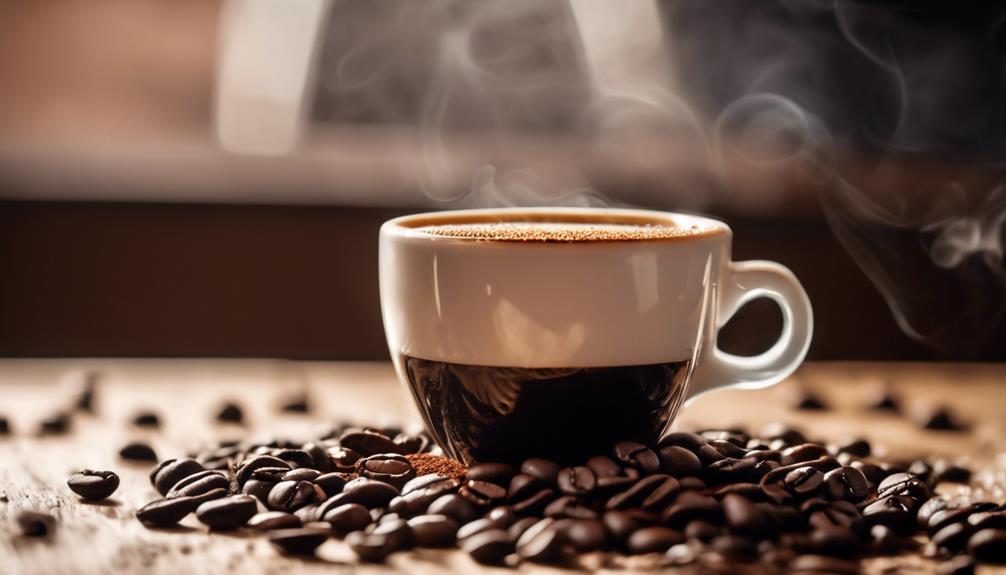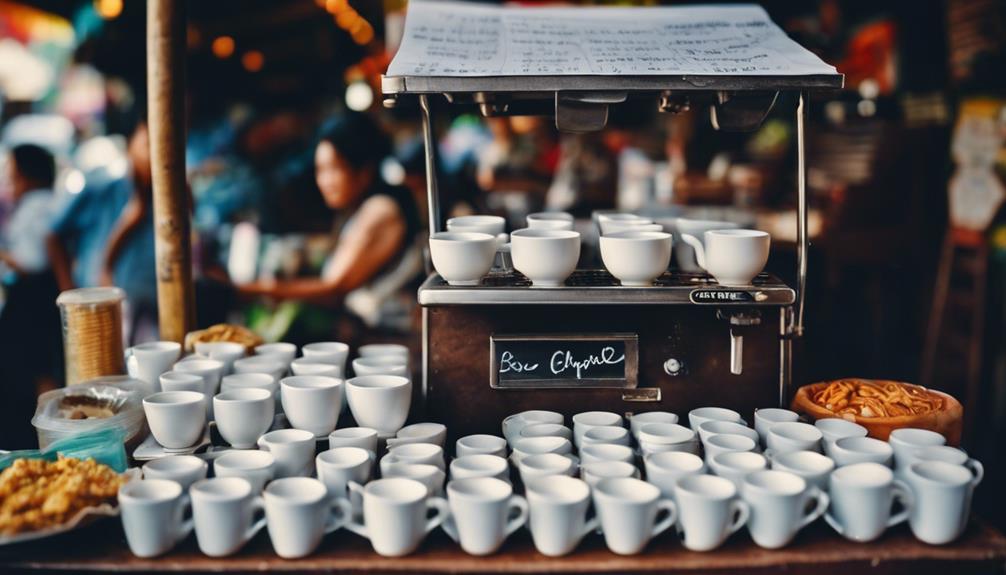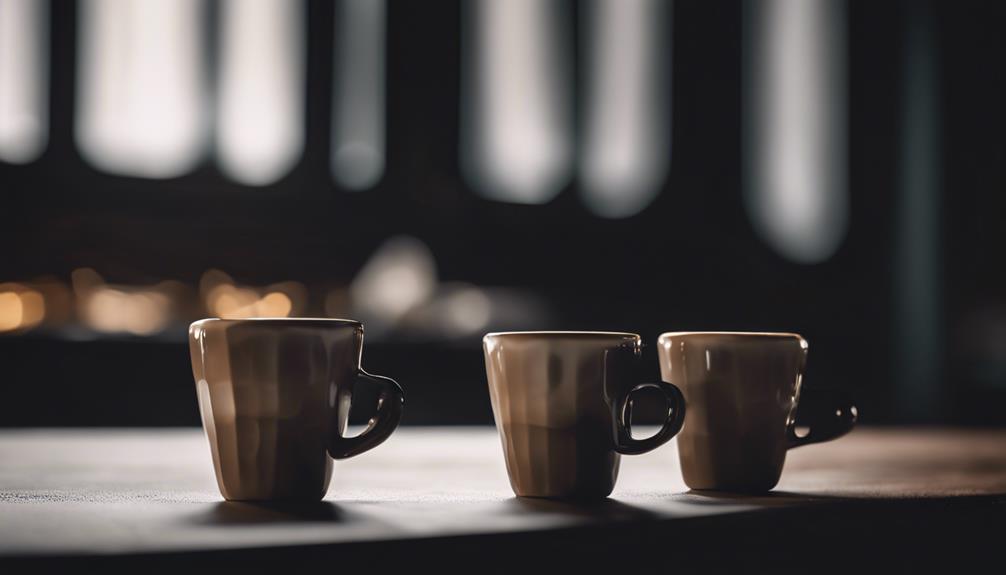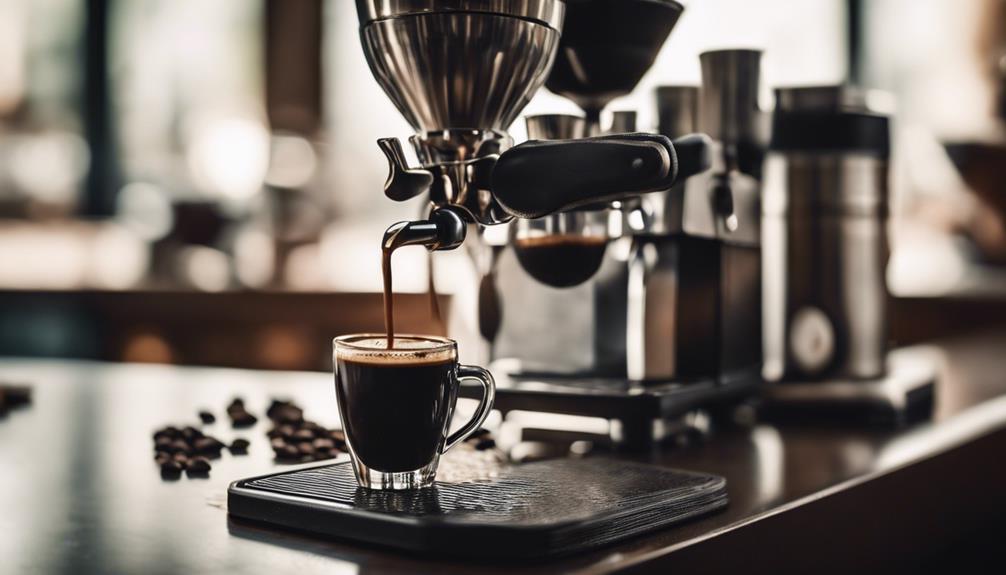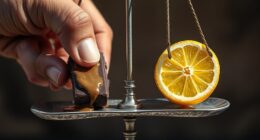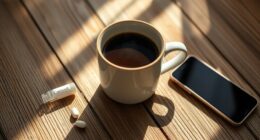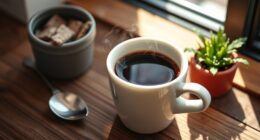You may be interested in learning about the caffeine content in your morning espresso shot. A standard 1-ounce shot typically contains around 63 milligrams of caffeine. However, this can vary based on the coffee beans used, roast level, and brewing method. For example, decaf espresso has only about 0.3 milligrams of caffeine per shot. Understanding these basics may lead you to wonder how the caffeine content impacts you individually, as well as what other factors contribute to the perfect shot – and this is just the tip of the iceberg in the fascinating world of espresso.
Key Takeaways
- A standard 1-ounce shot of espresso typically contains approximately 63 mg of caffeine.
- Decaf espresso contains about 0.3 mg of caffeine per shot, a negligible amount.
- Caffeine content in espresso varies depending on brewing method, coffee bean type, and roast level.
- Darker roasts typically have lower caffeine due to prolonged roasting, while lighter roasts may yield slightly higher levels.
Caffeine Content in Espresso
When you order a shot of espresso, you're likely getting a concentrated dose of caffeine, with a standard 1-ounce serving averaging around 63 milligrams. However, the calorie content of a shot of espresso is minimal, with only around 3-4 calories per serving. This makes it a popular choice for those looking for a quick pick-me-up without the added sugar or cream found in other coffee drinks. On the other hand, when you mix espresso with vodka and other liqueurs to make an espresso martini, the calorie count can increase significantly. If you’re watching your calorie intake, it’s important to be mindful of the espresso martini calories in each serving.
However, the amount of caffeine you get can vary depending on the type of espresso you order. For instance, a double shot, also known as a doppio, typically packs around 125 milligrams of caffeine. Even the brewing method and type of coffee beans used can affect the caffeine content in your espresso.
Decaf espresso, on the other hand, still contains a small amount of caffeine – about 0.3 milligrams per shot. While it's not entirely caffeine-free, it's a much lower amount compared to regular espresso.
It's important to be aware of the caffeine content in your espresso, especially if you're sensitive to its effects. Knowing the amount of caffeine you're getting in each shot can help you make informed decisions about your coffee consumption.
Factors Affecting Caffeine Levels
As you explore the world of espresso, you'll notice that the type of coffee bean used can greatly impact the caffeine content of your shot.
You'll find that the roast level also plays a role, with darker roasts generally having lower caffeine levels.
Bean Type Matters
You'll find that the type of coffee bean you choose plays a crucial role in determining the caffeine levels in your shot of espresso. The bean type considerably influences the caffeine content, with Robusta beans containing about twice the caffeine of Arabica beans. This means that if you opt for a shot of espresso made from Robusta beans, you can expect a higher caffeine kick. On the other hand, if you prefer a milder shot, Arabica beans might be the way to go.
When it comes to brewing methods, the type of bean used can also impact the caffeine levels. Espresso made from finely ground beans allows for greater surface area and more efficient caffeine extraction during brewing, which can result in a more caffeinated shot.
However, it's crucial to remember that the caffeine content can vary greatly depending on the bean type and roast level. A single shot of espresso typically contains around 63 mg of caffeine, but this can vary depending on your choices. By selecting the right bean type, you can craft your perfect shot of espresso with the desired caffeine levels.
Roast Level Impacts
Your choice of roast level also plays a significant role in determining the caffeine content of your espresso shot, with darker roasts typically yielding lower caffeine levels due to the breakdown of caffeine molecules during the prolonged roasting process.
This means that if you opt for a lighter roast, you may end up with a shot that packs a slightly stronger caffeine punch. However, it's also important to take into account the type of coffee bean you're using.
Robusta beans, for instance, contain about twice the caffeine of Arabica beans, so an espresso made from Robusta can potentially yield higher caffeine levels.
The grind size you use for your espresso also affects caffeine extraction, with finer grinds increasing the surface area for better caffeine transfer during brewing.
And let's not forget about brewing methods – those that favor longer extraction times, like a lungo, can also impact the caffeine concentration, potentially yielding more caffeine than a standard espresso shot.
Espresso Vs. Regular Coffee
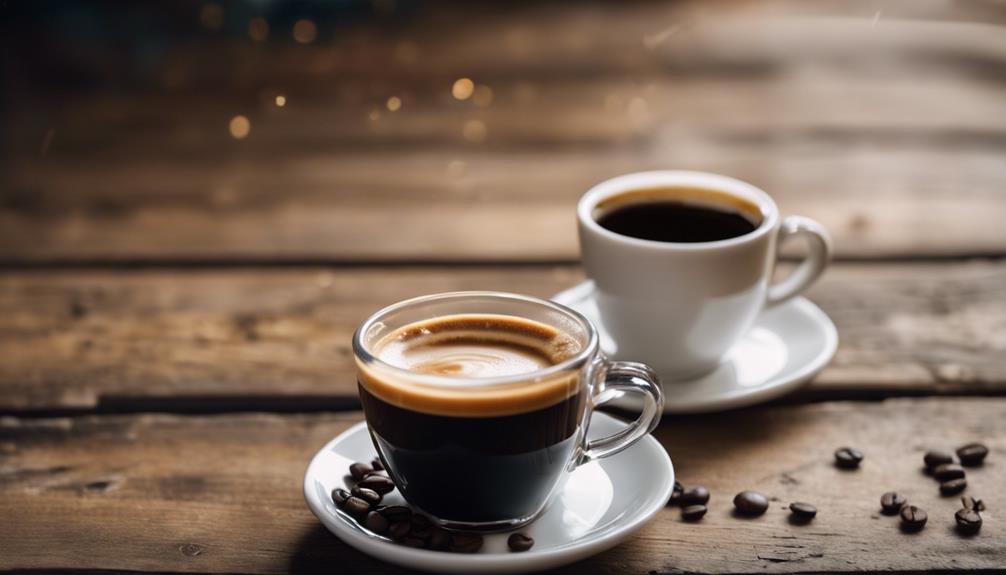
Now that you're aware of the caffeine content in a shot of espresso, you're probably wondering how it stacks up against regular coffee.
As you explore the differences between these two popular brews, you'll discover that the type of beans used, the roast level, and other factors all play a significant role in shaping the final product.
You'll soon see how these variables impact the flavor, aroma, and of course, the caffeine kick you get from your daily cup.
Espresso Beans Matter
Roasted to perfection, espresso beans are what set espresso apart from regular coffee, boasting a distinct flavor profile and caffeine content that can't be replicated.
You might wonder, what makes espresso beans so special? It's all about the roasting process and grind size. Espresso beans are roasted longer and ground more finely than regular coffee beans, resulting in a unique flavor profile and caffeine content.
The type of coffee bean also plays a significant role in caffeine levels. Robusta beans, for instance, contain about twice the caffeine of Arabica beans.
When you brew espresso, the fine grind size increases the surface area for water to extract caffeine more efficiently than regular coffee grounds. This is why espresso has a higher caffeine concentration per ounce than brewed coffee.
However, despite this concentration, a single shot of espresso generally contains less overall caffeine than an equivalent volume of brewed coffee.
Coffee Bean Differences
You might be surprised to learn that espresso and regular coffee can be made from the same coffee beans, but it's the differences in roasting and grinding that set them apart. While the coffee beans themselves may be the same, the way they're prepared makes all the difference.
Here are some key differences between espresso and regular coffee:
- Roasting: Espresso beans are typically roasted longer to bring out a deeper flavor and aroma.
- Grind size: Espresso requires a finer grind size to increase the surface area for better caffeine extraction during the brewing process.
- Brewing process: The high-pressure brewing method used for espresso produces a concentrated shot with a higher caffeine concentration than regular coffee.
- Caffeine content: Although espresso has a higher caffeine concentration per ounce, a typical serving size for brewed coffee is larger, resulting in a higher total caffeine content per serving.
These differences in roasting, grinding, and brewing result in distinct flavor profiles and caffeine levels between espresso and regular coffee. Understanding these differences can help you appreciate the unique characteristics of each.
Roast Type Affects
How does the type of roast you choose impact the flavor and caffeine kick of your espresso versus regular coffee?
When it comes to espresso, the roast type plays a significant role. Typically, espresso beans are roasted longer than regular coffee beans, resulting in a stronger flavor profile and a different caffeine concentration.
You might think that darker roasts would pack a bigger caffeine punch, but it's actually the opposite. Darker roasts often contain less caffeine than lighter roasts due to the breakdown of caffeine molecules during the roasting process.
This means that if you prefer a lighter roast for your espresso, you might get a slightly higher caffeine kick. However, the type of coffee bean also comes into play. Robusta beans, commonly used in espresso, have about twice the caffeine content of Arabica beans typically used for regular coffee.
Caffeine Perception and Effect
As you savor a shot of espresso, the concentrated dose of caffeine can hit you like a bolt, making its effects seem more pronounced than they'd from a comparable amount in brewed coffee. This is because the rapid consumption of espresso can enhance the feeling of alertness and energy, whereas the slower sipping of regular coffee can lead to a more gradual increase in perceived energy.
Here are some key factors that influence your caffeine perception and effect:
- Individual tolerance: Your personal sensitivity to caffeine can greatly impact how you experience its effects, so what might be an energizing boost for someone else mightn't have the same impact on you.
- Psychological context: The environment in which you consume espresso, such as a busy coffee shop or a quiet morning at home, can also affect how you perceive the caffeine's effects.
- Rapid consumption: The quick hit of caffeine from espresso can create a sense of immediate alertness and energy.
- Caffeine perception: Your brain's interpretation of the caffeine's effects can be influenced by these factors, making the experience of drinking espresso unique to you.
Health Recommendations and Limits
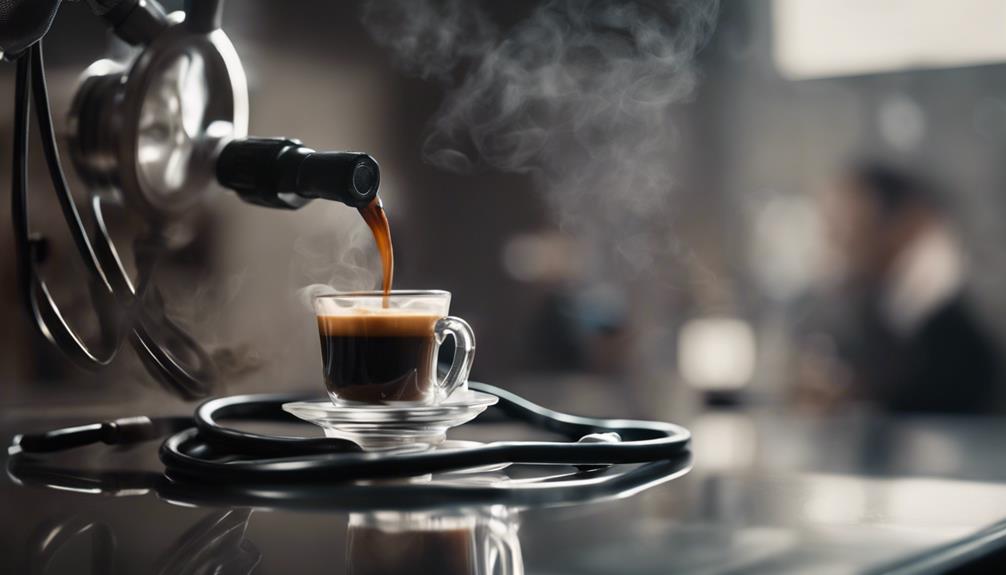
According to established health guidelines, moderate caffeine consumption, including espresso, is generally considered safe when kept within recommended daily limits. As you enjoy your shot of espresso, it's important to be mindful of your daily caffeine intake. The FDA recommends a safe daily caffeine limit of 400 mg for healthy adults, equivalent to about two to four 8-ounce cups of brewed coffee.
Here's a breakdown of the recommended caffeine limits:
| Group | Recommended Daily Caffeine Limit |
|---|---|
| Healthy Adults | 400 mg |
| Pregnant Women | 200 mg |
| General Guideline | 2-4 cups of brewed coffee |
One shot of espresso typically contains about 63 mg of caffeine, making it a controlled option for those monitoring their intake. Moderate caffeine consumption, including espresso, may enhance mood and cognitive function without exceeding health recommendations. By being aware of your daily caffeine limit, you can enjoy your espresso while staying within recommended caffeine limits, especially when combined with milk-based drinks like lattes.
Espresso and Coffee Equipment
You'll need quality espresso machines to produce high-quality shots, and consumer reports have identified specific brands that deliver ideal brewing results. To get the most out of your espresso experience, consider the following:
- Grind size matters: A fine grind, similar to table salt, is essential for best extraction.
- Extraction pressure is key: Aim for around 9 bars to bring out the best flavors.
- Choose your brewing method: Traditional machines, stovetop Moka pots, and portable espresso makers each offer unique flavors and experiences.
- Invest in good equipment: It can greatly enhance the flavor and overall coffee experience, making it worthwhile for enthusiasts.
When selecting an espresso machine, read user reviews to find the best fit for you. They often highlight the performance and reliability of various machines, emphasizing the importance of choosing the right equipment for consistent results.
Caffeine in Espresso Drinks

When you order an espresso drink, the amount of caffeine it contains can vary greatly, ranging from a modest 75 milligrams in a small cappuccino to a whopping 300 milligrams in a large Americano. This is because the number of espresso shots used in each drink affects the caffeine content.
A single shot of espresso typically contains 75 mg of caffeine, while a double shot has about 150 mg. Espresso drinks like cappuccinos and lattes usually contain 75 mg of caffeine for shorter sizes and 150 mg for larger sizes, depending on the number of shots used.
Mochas can have 90 mg of caffeine for smaller sizes and up to 180 mg for larger sizes due to the added chocolate. Americanos, on the other hand, can range from 75 mg of caffeine for smaller sizes to 300 mg for larger sizes, depending on the number of espresso shots.
Health Benefits and Nutrition
As you savor your shot of espresso, you're not only getting a caffeine boost, but also a dose of essential nutrients like B vitamins and potassium that contribute to your overall well-being.
Here are some of the key health benefits you can expect from moderate espresso consumption:
- Improved mental alertness: The caffeine in espresso can help increase your focus and alertness, making it an excellent pick-me-up for those morning slumps.
- Antioxidant power: Espresso is rich in antioxidants, which can help reduce inflammation and lower the risk of certain diseases, such as Parkinson's and Alzheimer's.
- Enhanced physical performance: Caffeine can increase adrenaline levels and mobilize body fat, making it an excellent pre-workout drink to boost your physical performance.
- Lower mortality rates: Regular consumption of espresso, within safe limits, is associated with lower mortality rates and potential health benefits.
Coffee Consumption Trends
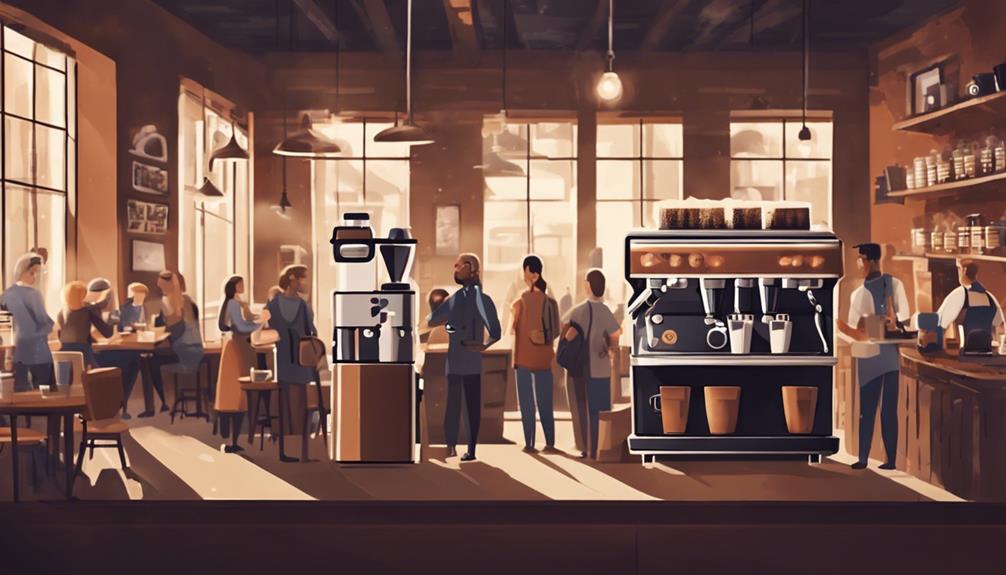
Drinking coffee has become an integral part of daily routines, with a staggering 70% of Americans consuming it weekly and 62% daily. As you're likely part of this majority, you might be curious about understanding the current coffee consumption trends.
Notably, your age plays a role in how you consume coffee. If you're between 18-24, you're probably having coffee with breakfast, just like 70% of your peers. However, if you're older, you're more likely to have coffee with breakfast, with 90% of older drinkers doing so.
Regional differences also impact how you perceive and experience the caffeine kick from espresso. In the U.S., the coffee culture is evolving, with a growing interest in specialty drinks, including espresso-based beverages.
As a coffee enthusiast, you might be pleased to know that moderate coffee consumption, estimated at 2 to 4 cups daily, is associated with various health benefits and improved cognitive function.
Frequently Asked Questions
How Much Caffeine Is in a Single Shot of Espresso?
You're wondering how much caffeine is in a single shot of espresso? Well, typically, it's around 63-75 mg per 1-ounce serving, but it can range from 29-100 mg depending on the beans, roast, and grind! The caffeine content in espresso shots can also vary based on the brewing method and the size of the shot. For example, a double shot of espresso will have approximately twice the caffeine as a single shot. Additionally, the length of extraction time can impact the caffeine content, as a longer extraction time can result in a higher caffeine concentration in the final product.
Is 2 Shots of Espresso a Lot of Caffeine?
You're considering a double shot of espresso, right? Let's say your friend Emma, a coffee newbie, downs two shots before a morning meeting – that's around 126-150mg of caffeine, which might be too much for her, but okay for you, depending on your sensitivity.
How Much Caffeine Is in 1 Shot of Starbucks Espresso?
You're wondering how much caffeine is in 1 shot of Starbucks espresso? Well, you'll get around 75mg of caffeine in that 0.75-ounce shot, which is considerably more than regular brewed coffee!
What Is Considered 1 Shot of Espresso?
Are you wondering what makes a shot of espresso official? You consider a standard shot of espresso to be 1 ounce in volume, typically served in a demitasse cup, and that's what most coffee shops, including Starbucks, abide by.
Conclusion
You've now got a grip on the caffeine buzz in your favorite shot of espresso!
Like a perfectly pulled shot, the facts are clear: caffeine levels vary, equipment matters, and health limits exist.
As you savor your next espresso, remember that it's not just a drink, but a complex blend of art, science, and nutrition.
So go ahead, indulge in that rich flavor, but do it responsibly – your body (and taste buds) will thank you!
